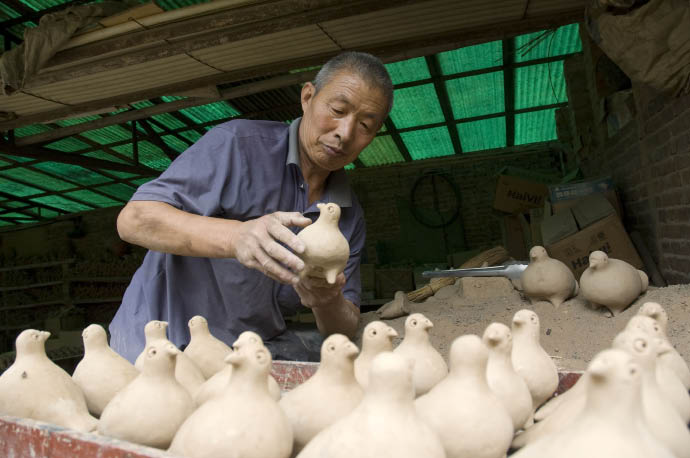|
Nigugu in Xunxian County
Xunxian County is located in northern Henan Province and was a garrison county for peasant uprising troops at the end of the Sui Dynasty (581-618). Some of the soldiers were good at making clay sculptures and created many figures in memory of those who had been killed in battle. When the uprising succeeded, many demobilized soldiers settled in the area and handed down the craft of making clay figurines.
Nigugu are made in a variety of animal and bird figures and range in size from 4 cm up to 20 cm. But their modest size is in contrast to their exquisite appearance. The background color is usually black but sharp contrasts are formed with bright motifs painted in red, yellow, green and other vibrant colors.
The special thing about Xun-xian County clay figures is that they can whistle: there are two small holes on the body that make a coo-coo sound when blown into. The name nigugu can be translated as "clay coo-coo."
 |
|
Preparing nigugu for one or two days of kiln-firing. Photos by China Foto Press |
Salvation of a Tradition
In common with many other traditional crafts in a modern society, the making of clay figurines is in danger of extinction. The younger generations like the products, but few show much interest in learning the skills, aware that their making is a complicated process but one that reaps meager profits.
Step in the government, with a range of policies and funding to help preserve and pass on the craft: institutions and factories specializing in this folk art have been established in recent years; first-rate examples are being acquired for national museum collections and displayed in art galleries; increasingly, young people are getting apprenticed to respected craftsmen and are determined to inherit and spread clay figurine culture.
Family workshops like Clay Figurine Zhang no longer confine their teaching to family members exclusively, but will take on those willing to make a lifelong career of the art. Today, the fourth generation of Clay Figurine Zhang is transmitting its precious skills to the fifth. Apprentices are required to learn basic skills and to take related courses on culture.
Many exponents have been invited abroad to demonstrate their art and to exchange ideas with counterparts overseas. Huishan Clay Figurine Studio, for example, has benefited greatly from communication and cooperation with foreign folk-art circles. The largest clay figurine workshop in China, the studio produces more than two million clay sculptures every year and interaction with artists worldwide has greatly inspired the local craftsmen, adding to the popularity of their creations on the global market. Currently, over 80 percent of the studio's output is exported. | 